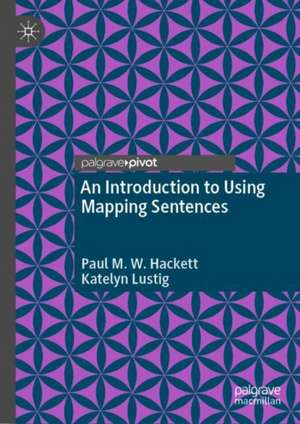An Introduction to Using Mapping Sentences
Autor Paul M. W. Hackett, Katelyn Lustigen Limba Engleză Hardback – 25 aug 2021
This book acts as an introductory guide to understanding and using the mapping sentence as a tool in social science and humanities research. The book fills the need for a concise text that simply instructs how and when to use a mapping sentence and provides practical examples. Mapping sentences are a major research component and tool of facet theory. The book begins by covering the background to mapping sentence, including the philosophy and theory underpinning it. The following chapter discuss what mapping sentence is, what different kinds of mapping sentences exist, and knowing when and which to use it in a given situation. The book then moves into describing how to write a mapping sentence and how to analyse the information gained from mapping sentence research. It ends with a consideration of the future developments of mapping sentences and their applications across the social sciences and humanities, including in particular psychology, marketing, behavioural biology,art and health.
Preț: 482.94 lei
Nou
Puncte Express: 724
Preț estimativ în valută:
92.41€ • 95.34$ • 77.12£
92.41€ • 95.34$ • 77.12£
Carte tipărită la comandă
Livrare economică 27 martie-10 aprilie
Preluare comenzi: 021 569.72.76
Specificații
ISBN-13: 9783030785819
ISBN-10: 3030785815
Pagini: 114
Ilustrații: XIX, 105 p. 18 illus., 1 illus. in color.
Dimensiuni: 148 x 210 mm
Greutate: 0.3 kg
Ediția:1st ed. 2021
Editura: Springer International Publishing
Colecția Palgrave Macmillan
Locul publicării:Cham, Switzerland
ISBN-10: 3030785815
Pagini: 114
Ilustrații: XIX, 105 p. 18 illus., 1 illus. in color.
Dimensiuni: 148 x 210 mm
Greutate: 0.3 kg
Ediția:1st ed. 2021
Editura: Springer International Publishing
Colecția Palgrave Macmillan
Locul publicării:Cham, Switzerland
Cuprins
Chapter 1 Background to Facet Theory.- Chapter 2 Mapping sentences defined.- Chapter 3 Different types of mapping sentences.- Chapter 4 Developing a mapping sentence.- Chapter 5 Examples of Mapping sentences.- Chapter 6 Analysing the information that arises from research designed using a mapping sentence.- Chapter 7 Conclusions.
Notă biografică
Paul M.W. Hackett is a visiting professor at the University of Suffolk, UK and has published widely on facet theory in books and articles. He has PhDs in psychology and in art and has held academic positions at Durham, Cambridge, Oxford and Birmingham in the UK and at Tufts Universities and Emerson College in the US. Hackett developed the declarative mapping sentence as an approach to qualitative and philosophically oriented research.
Katelyn Lustig is a writer and researcher with a bachelor's degree in marketing communication from Emerson College, USA. She has co-authored two books on Facet theory and the mapping sentence. She translates these research tools and theories in a manner that students may be able to better understand and appreciate in simpler terms.
Katelyn Lustig is a writer and researcher with a bachelor's degree in marketing communication from Emerson College, USA. She has co-authored two books on Facet theory and the mapping sentence. She translates these research tools and theories in a manner that students may be able to better understand and appreciate in simpler terms.
Textul de pe ultima copertă
“This book presents a concise introduction to a research methodology that is particularly apposite to the social and behavioural sciences. It is written by two experts who have themselves used and developed the mapping sentence approach through their own empirical research and theoretical deliberations. It brings together a wealth of ideas and insights that will be of value to new and experienced scholars alike.”
Professor Gordon R. Foxall, Distinguished Research Professor, Cardiff University, UK and Visiting Research Professor, Reykjavik University, Iceland
Professor Gordon R. Foxall, Distinguished Research Professor, Cardiff University, UK and Visiting Research Professor, Reykjavik University, Iceland
Caracteristici
Introduces readers to mapping sentences Provides concrete examples for when and how to use mapping sentences in applied and theoretical research Considers the future developments of mapping sentences and their application
